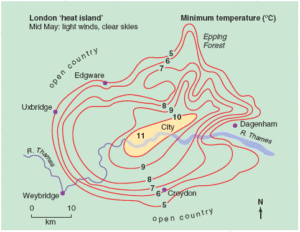by Roger A. Pielke Sr, July 25, 2019
The urban heat island effect is a well-documented example of inadvertent modification of climate by human activities in the form of increased temperatures of urban areas compared to a city’s rural surroundings. It is a fine example of how changing the energy balance of a region can affect the regional climate.
On average, the city is warmer than the countryside because of differences between the energy gains and losses of each region. There are a number of factors that contribute to the relative warmth of cities, such as heat from industrial activity, the thermal properties of buildings, and the evaporation of water. For example, the heat produced by heating and cooling city buildings and running planes, trains, buses, and automobiles contributes to the warmer city temperatures. Heat generated by these objects eventually makes its way into the atmosphere, adding as much as one third of the heat received from solar energy. The architecture of cities intensifies UHI effect. The canyon shape of the tall buildings and the narrow space between them magnifies the longwave energy gains. During the day, solar energy is trapped by multiple reflections off the many closely spaced, tall buildings, reducing heat losses by longwave radiation (See schematic below). Pollution in the city’s air also modifies the absorption of longwave and shortwave radiation of the atmosphere.
…

